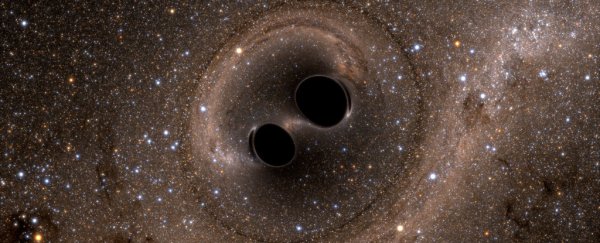When scientists finally detected the existence of gravitational waves last year, it wasn't just a landmark moment confirming Einstein was right all along.
That cosmos-spanning signal was traced to the ancient merging of two black holes some 1.3 billion years ago. Forget worlds colliding – this merger was unimaginably more intense and powerful – and the fact it happened at all means we may have overlooked something huge.
"Fundamentally, the detection of gravitational waves was a huge deal, as it was a confirmation of a key prediction of Einstein's general theory of relativity," says astrophysicist James Bullock from the University of California, Irvine.
"But then we looked closer at the astrophysics of the actual result, a merger of two 30-solar-mass black holes. That was simply astounding and had us asking, 'How common are black holes of this size, and how often do they merge?'"
For 18 months after LIGO's historical discovery, Bullock's team ran theoretical calculations on what we know about galaxies and stars – and the unquenchable black holes that form in their wake.
Having done the math for a kind of 'cosmic inventory', the researchers think we've vastly underestimated how many of these dark voids are out there lurking in space – and say there are probably tens of millions of them throughout the Milky Way, maybe even more.
"We think we've shown that there are as many as 100 million black holes in our galaxy," says Bullock.
Stellar-remnant black holes are born when massive stars collapse on themselves, having run out of fuel at the end of their lives.
Scientists think that most of these kinds of black holes have roughly comparable mass to our Sun, but the epic black holes behind LIGO's gravitational wave discovery had way more mass.
The difference can be explained by how metal-rich these objects were in their former lifetimes as stars. Metal-rich stars like the Sun shed a lot of the heavy elements they contain over their lifespans, producing a lower-mass black hole when their light goes out.
In contrast, stars with less heavy elements release less of their mass over their lives, ultimately producing a black hole with greater mass.
By calculating what we know about the existence and distribution of such stars throughout the galaxy, the team was able to infer a spectrum of the black hole population in the Milky Way – including the kind of binary black holes that merged to give us gravitational waves.
"We have a pretty good understanding of the overall population of stars in the Universe and their mass distribution as they're born, so we can tell how many black holes should have formed with 100 solar masses versus 10 solar masses," Bullock explains.
"We were able to work out how many big black holes should exist, and it ended up being in the millions – many more than I anticipated."
Specifically, of the up to 100 million black holes the team estimates are out there, some 10 million of them are thought to have 50 times the mass of the Sun.
Given the high numbers we're talking about here, the researchers say mergers are a phenomenon we should expect to see more of – a theoretical explanation for how LIGO has already detected more gravitational waves, and not just once, but twice.
"Right now, we know these black hole mergers are occurring in some broad swath of the sky, but not with much precision," Bullock told Brian Whitehead at The Orange Country Register.
"There's hope we'll be able to triangulate their positions in the sky (and) begin to figure out what galaxy they're merging in."
In the meantime, the researchers say there's no need to worry – even though their findings mean that the night sky holds more invisible, ravenous mouths than we ever truly understood.
"It's not like we need to go out and buy black hole insurance soon; not like we're in danger of being sucked into a black hole any more than we were before," said Bullock.
"It's just amazing that the Universe was created out of things like this."
The findings are reported in Monthly Notices of the Royal Astronomical Society.
